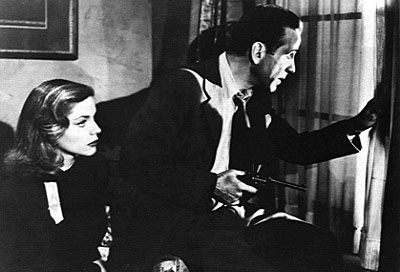French film critics concussed the term “Film Noir” in 1946. Due to the war and the German occupation not much cinema could be imported or screened in France during those years and the sudden release of all the movies left critics and audiences in awe and amazement. I dare say that it was the sudden release of these films that allowed French film viewers and critics to recognize certain common traits and moods between the movies. As Billy Wilder recognizes in an interview, filmmakers were not aware of the term “Film Noir” while they made the movies.
The French noticed a certain similarity between the gangster film, the police genre and the detective fiction. Authors like Raymond Chandler, James Cain, and Dashiell Hammett among others were already well know writers and film viewers were already familiar with some of the novels that served as inspiration to the movies, such as The Postman Always Rings Twice, Double Indemnity, Farewell, My Lovely and The Maltese Falcon.
It is no coincidence that when you look up the definition of detective fiction you find that it resembles the definition(s) that critics tend to give of film noir. However, a closer reading of the attempts to define noir as a genre reveals that scholars have found it impossible to capture and define its essence in any absolute sense. In her article on Film Noir and Women, Elizabeth Cowie (in Copjec’s Shades of Noir) discusses the public’s fascination with film noir and how this plays a crucial role in the construction of the category as such.
“Whether it is a genre, a cycle of films, a tendency or a movement, film noir has been extraordinarily successful as a term. As a ‘genre that never was’ – since the term was not used by the studios themselves, or by the audiences at the time..[..] The term has succeeded despite the lack of any straightforward unity in the sets of films it attempts to designate. This tenuousness is matched by a tenacity of critical use, a devotion among aficionados that suggest a desire for the very category as such, a wish that it exist in order to ‘have’ a certain set of films altogether. Film noir as a genre is in a certain sense a fantasy…” (pg. 121)
Cowie does not deny the particular style, or phenomena, present in the Hollywood cinema of the 1940’s and 50’s, she merely points out the contradictions that the study of film noir poses and the discrepancy between the canon and the term itself.
Among early critics and enthusiasts there was a tendency to define noir; Borde and Chaumeton, for example, argue that the presence of crime constitutes noir’s most essential characteristic. The inclination to find boundaries has led critics to disagree on noir’s essential ingredients, although recent criticism is more aware of the dangers of such a limited scope. French film critic, Andre Bazin, aware of the difficulty of delimiting noir as a genre, suggests that we consider noir as a style. This allows the term more flexibility than the designation ‘genre’ and it also points to the limitations of inscribing noir in a singular or series of definitions.
Bazin is correct in pointing out film noir’s peculiar style. It is in fact it’s style, what attracted audiences to it and what we as contemporary viewers tend to admire the most. Noir’s style was greatly influenced by the German Expressionism that was imported to Hollywood when both Austrian and German filmmakers immigrated to the US to escape the war. Figures like Billy Wilder, Fritz Lang, Robert Siodmak, Otto Preminger, are among the filmmakers that are most alluded when one refers to the cannon of noir films.
Watching a ‘noir movie’ is always an exquisite experience precisely because, despite the fact that they were B-movies, there are very ‘stylized’; their convoluted voice over narrations, their costume design (the hats, the rain coats, the femme fatale’s attires, the cigarette holders, etc), their witty dialogue and the cleverness of their characters, the camera work and moreover the lighting, are among the traits that define such style. (One of the most beautiful and influential camera work was done by cinematographer John Alton)
Theorizing on the term ‘film noir’ can be difficult and so critics and scholars have a tendency to look for common traits shared by (what is understood as) its canon of films. Many documents define noir as an essentially male discourse. One of the most common scenarios presents a male character, usually a detective, cop, journalist, agent or even a criminal, confronted with a crime and with a ‘choice’ between two women. Often a tension arises between the two opposite female characters, usually good and evil. Most films share a fatalistic tone with a pessimism dominating the atmosphere. They usually narrate an urban tale that brings out the corruption of society and confronts the spectator with the idea of the ‘American dream’. Other features of film noir are the “use of high contrast lighting and other ‘expressionistic’ devices, the focus on mentally, emotionally and physically vulnerable characters, the interest in psychology, …the downbeat emphasis on violence, anxiety, death, crime and compromised morality”(Neale, 174), and the convoluted relations between male and female characters.
Towards a definition of Film Noir,



No user commented in " Towards a definition of Film Noir "
Follow-up comment rss or Leave a TrackbackLeave A Reply